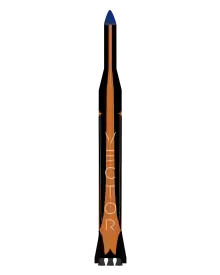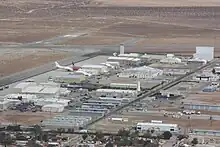Vector-R
Vector-R (Vector Rapid) is a two-stage orbital expendable launch vehicle under development by the American aerospace company Vector Launch to cover the commercial small satellite launch segment (CubeSats).[3] Vector Launch went bankrupt in December 2019 and re-emerged in October 2020.[4] Two prototypes were launched in 2017.
 | |
| Function | Small satellite launch vehicle |
|---|---|
| Manufacturer | Vector Launch |
| Country of origin | United States |
| Cost per launch | 2–3 million USD |
| Size | |
| Height | 12 m |
| Diameter | 1.2 m |
| Mass | 5,000 kg |
| Stages | 2/3 |
| Capacity | |
| Payload to LEO | |
| Mass | 60 kg [1] |
| Payload to SSO | |
| Mass | 26 kg [2] |
| Associated rockets | |
| Family | Vector (rocket family) |
| Derivative work | Vector-H |
| Comparable | Electron, Falcon 1, Firefly Alpha |
| Launch history | |
| Status | Active |
| Launch sites | Mojave Air and Space Port Spaceport Camden Pacific Spaceport Complex – Alaska (planned) MARS Pad OB (planned) Spaceport Florida Launch Complex 46 (planned) |
| Total launches | 2 |
| Success(es) | 2 |
| Failure(s) | 0 |
| First stage | |
| Diameter | 1.2 m (3 ft 11 in) |
| Powered by | 3 X Hadley |
| Maximum thrust | 15,000 lbf (67,000 N) |
| Propellant | Kerosene / LOX |
| Second stage | |
| Diameter | .635 m (2 ft 1.0 in) |
| Powered by | 1 X LP-2 |
| Maximum thrust | 1,000 lbf (4,400 N) |
| Burn time | 433 seconds |
| Propellant | Propylene / LOX |
The rocket completed a maiden test flight at low altitude in May 2017.[5] Vector Launch was planning the maiden orbital launch from the Pacific Spaceport Complex in Alaska in 2019,[6] but paused operation in August 2019 due to an uncertain financing situation.[7]
An upgraded version of the Vector-R, called the Vector-H (Heavy), is in development as well.
Design
Vector-R plans to use two stages with a 1.2-meter (3.9 ft) diameter first stage and 0.635-meter (2.08 ft) diameter second stage, both filled with propylene/LOX propellant. The main body of the rocket will be constructed using a lightweight carbon composite material.[8]
The launch vehicle's first stage was to be powered by three LP-1 LOX/propylene engines, delivering 81,000 newtons of force. The second stage was to be powered by one LP-2 LOX/propylene engine, delivering 4,400 newtons of force. The engines used a 3D-printed engine injector, designed with help from NASA's Science, Technology and Mission Directorate (STMD) Flight Opportunities program. This allows the injector to be produced as a single piece of hardware, instead of as individual components.
Vector was aiming the rocket at a launch cadence of 100 vehicles per year.[9]
Block 0.1
The first two sub-orbital flight tests used the Vector-R Block 0.1 prototype model,[10] which was a full size aluminum air-frame of the Vector-R but with only one first stage engine.
Vector-RE1
The Vector-RE1, a planned variant, was planned to use the same body as the standard Vector-R but include an electric powered third stage.[10]
Intended usage
Vector-R was designed to launch a 60 kg (130 lb) payload to a 1,000 km (620 mi) Sun-synchronous orbit, suitable for CubeSats and other small satellites. The cost per launch was planned to be less than US$3 million, a price point that the company hoped would have allowed it to attract one hundred launches per year. Customers could have chosen to encapsulate their spacecraft in payload fairings provided by the company, which could be attached to the rocket shortly before launch, in several different configurations, such as fitting CubeSats dispensers or multiple satellites in a single fairing.
Vector used on-site payload integration for the early launches. However it was expected to be able to integrate payloads at their Arizona and California payload facilities and ship them to their launch sites.
Launch sites

Vector-R launched from the Mojave Air and Space Port and Spaceport Camden for its flight tests. It had completed one test flight from each pad. Flight B0.002 was also the first launch from Spaceport Camden.
Vector planned to use the LC-46 launch site in Florida and the Mid-Atlantic Regional Spaceport (MARS) Pad 0B[11] for the Vector-R rocket, with the first all-up launches would have occurred from MARS Pad 0B.[12] Additionally, Vector investigated adding more minimal infrastructure launch pads either located on land in the US, or to launch the rocket from barges on the ocean.[2]
Vector had planned for the maiden orbital launch from Kodiak Spaceport Launch Complex earlier in 2019.[13]
Launch statistics
Two low altitude suborbital test flights were performed in 2017.
Launch history
| Flight № | Date / time (UTC) | Rocket configuration |
Launch site | Payload | Payload mass | Orbit | Customer | Launch outcome |
|---|---|---|---|---|---|---|---|---|
| B0.001 | 3 May 2017 19:00[14] |
Vector-R (P-19H) | Mojave[15] | None | — | Sub-orbital | Vector Launch | Success |
| Flight test; maiden flight of the Vector-R; first engineering test, scaled down version; scheduled altitude 4,500 feet. | ||||||||
| B0.002[16] | 2 August 2017 16:15 |
Vector-R | Camden[17] | Two customer payloads. | Sub-orbital | Astro Digital | Success | |
| Flight test; full prototype version, upgraded flight systems; the launch was delayed due to ignition detection failure; launch took place from a trailer; the peak altitude was about 5,000 ft. | ||||||||
Planned launches
Due to the bankruptcy and subsequent re-emergence of Vector, These launches are uncertain.
| Date / time (UTC) | Rocket configuration |
Launch site | Payload | Orbit | Customer |
|---|---|---|---|---|---|
| TBA | Vector-R | TBA | TBA | LEO? | TBA |
| B1001;[18] First launch since re-emergence of bankruptcy. | |||||
| TBA | Vector-R | Camden[10] | Sub-orbital | Vector Launch | |
| B0.003;[19] Flight-Test; Testing fairings, avionics, and thrust vector control | |||||
| TBA | Vector-R | PSCA[20] | Unicorn 2A Delfi-PQ 1[21] |
LEO | Alba Orbital Delft University of Technology |
| First orbital and commercial flight of the Vector-R. PocketQube launch. | |||||
| TBA | Vector-R | MARS LP-0B / PSCA | Landmapper-HD | LEO | Astro Digital |
| Earth observation | |||||
| TBA | Vector-R | Open Cosmos | |||
See also
References
- "Vector-R (Rapid)". Vector-launch.com. Retrieved 27 October 2018.
- "Vector-R : Payload User's Guide" (PDF). Vector-launch.com. Archived from the original (PDF) on 27 March 2018. Retrieved 27 October 2018.
- "Vector Space Systems raises funds to develop small launch vehicle - SpaceNews.com". SpaceNews.com. 2016-04-26. Retrieved 2017-03-22.
- "3. 2. 1. We're baaa-ack!".
- "Vector has completed the first successful flight test of its new micro rocket". 2017-05-03. Retrieved 2017-05-04.
- VECTOR (22 February 2018). "This week, Vector submitted its first launch application to the @FAANews to enable orbital launching from the Pacific Spaceport Complex - Alaska, later this year". @vectorspacesys. Retrieved 2018-02-25.
- "Small satellite launcher Vector pauses operations after ousting CEO". 10 August 2019.
- "Vector-R (Rapide) - Vector Space Systems". Vector Space Systems. Retrieved 2017-03-22.
- "Tiny rocket company aims for 100 launches a year—and it just might succeed". Ars Technica. Retrieved 2017-03-22.
- "Vector". Space.skyrocket.de. Retrieved 27 October 2018.
- "Vector to perform first orbital launches from Virginia". SpaceNews.com. 24 October 2017. Retrieved 27 October 2018.
- Vector Space aims to expand launch ranges with minimal infrastructure pads NasaSpaceflight.com
- VECTOR (22 February 2018). "This week, Vector submitted its first launch application to the @FAANews to enable orbital launching from the Pacific Spaceport Complex - Alaska, later this year". @vectorspacesys. Retrieved 2018-02-25.
- "Vector Space Makes 1st Test Launch of Small-Satellite Rocket". Space.com. 3 May 2017. Retrieved 27 October 2018.
- "Vector Becomes First to Complete Successful Flight Test of Launch Vehicle". PR Newswire. 3 May 2017. Retrieved 2017-11-11.
- Vector. "Vector Successfully Launches First Ever Rocket from Spaceport Camden". www.prnewswire.com. Retrieved 27 October 2018.
- Henning, Allyson (2 August 2017). "Camden Spaceport sees 1st launch". Jacksonville, FL: WJXT. Archived from the original on 2017-11-11. Retrieved 2017-11-11.
- "11 Oct 22, Vector-R B1001. First mission soon". 11 October 2022. Retrieved 11 October 2022.
- Cantrell, Jim (3 February 2018). "Our @vectorspacesys B0.003 vehicle being readied in our new factory in #Tucson for flight later in March testing multiple subsystems including fairings, avionics, and thrust vector control systems on a suborbital flight. Stay tuned !pic.twitter.com/54Nf3CwKiI". @jamesncantrell. Retrieved 2018-02-25.
- "Vector planning first orbital launch this summer". SpaceNews.com. 20 February 2018. Retrieved 27 October 2018.
- "Vector to Conduct Dedicated Launch of Alba Orbital PocketQube Satellites on First Orbital Attempt". PR Newswire. 8 March 2018. Retrieved 4 April 2018.